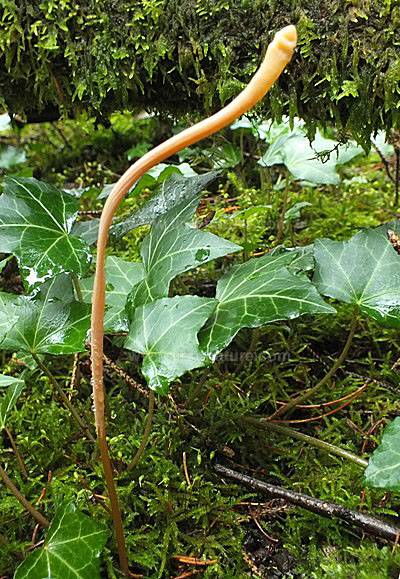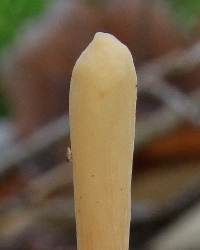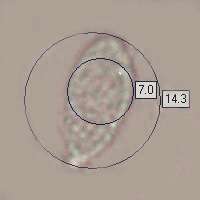Trees Birds Mammals Fish Amphibians Reptiles
Wild Algarve
Bookshop
Typhula fistulosa (Holmsk.) Olariaga - Pipe Club
Phylum: Basidiomycota - Class: Agaricomycetes - Order: Agaricales - Family: Typhulaceae
Distribution - Taxonomic History - Etymology - Identification - Culinary Notes - Reference Sources

Simple, unbranched clubs, often appearing singly but sometimes in small tufts, when they look like worms trying to become airborne, Pipe Clubs are soft and so flexible that in open locations they can be seen waving in even the gentlest of breezes.
Distribution
Fairly common throughout Britain and Ireland, Typhula fistulosa is one of those easily missed fungi, because its light brown stems look very much like twigs or young shoots yet to burst into leaf. This club fungus is found in most countries in mainland Europe, and it is reported also from parts of North America.

Taxonomic history
Some club-like and coral-like fungi are ascomycetous, but fairy clubs of Typhula and related genera belong to the Basidiomycota.
Pipe Club was first described scientifically in 1790 by Danish mycologist Johan Theodor Holmskjold (1731 - 1793), who gave it the binomial scientific name Clavaria fistulosa. The currently-accepted scientific name Typhula fistulosa dates from a 2013 publication by Spanish mycologist Ibai Olariaga.
Synonyms of Typhula fistulosa include Clavaria fistulosa Holmsk., Clavaria ardenia Sowerby, Tremella ferruginea Schumach., Clavariadelphus fistulosus (Holmsk.) Corner, Typhula fistulosa (Holmsk.) Olariaga, and Macrotyphula fistulosa (Holmsk.) R.H. Petersen.
Etymology
The generic name Typhula comes from Latin and means slightly smokey. Much more obvious, and again from Latin, is the specific epithet fistulosa, which simply means shaped like a pipe or a tube.
Identification guide
 |
Fruitbody
Often somewhat laterally flattened and sometimes longitudinally grooved; occasionally straight but more often wavy; simple clubs with blunt, rounded or mitriform tips; ochre to light brown but occasionally more orange towards the fertile tips.
The individual stems are
typically 5 to 30cm tall and 5 to 10mm across. |
 |
Spores
Teardrop shaped, smooth, 10-16 x 5.5-8.5 µm; inamyloid, hyaline.
Spore print
White. |
Odour/taste |
Not distinctive. |
Habitat & Ecological role |
Saprobic, on the ground in leaf litter in deciduous woodlands and on woodland edges; sometimes growing from rotting wood, particularly birch. |
Season |
June to November in Britain and Ireland. |
Similar species |
Clavulinopsis fusiformis has a similar form but is golden yellow. |
Culinary Notes
Pipe Club fungi are reported to be inedible.
Reference Sources
Fascinated by Fungi, 2nd Edition, Pat O'Reilly 2016, reprinted by Coch-y-bonddu Books in 2022.
Petersen RH. (1972). 'Notes on clavarioid fungi. XII. Miscellaneous notes on Clavariadelphus, and a new segregate genus'. Mycologia 64 (1): 137–52.
Dictionary of the Fungi; Paul M. Kirk, Paul F. Cannon, David W. Minter and J. A. Stalpers; CABI, 2008
Taxonomic history and synonym information on these pages is drawn from many sources but in particular from the British Mycological Society's GB Checklist of Fungi.
Acknowledgements
This page includes pictures kindly contributed by James Wainscoat.
Top of page...
Fascinated by Fungi. Back by popular demand, Pat O'Reilly's best-selling 450-page hardback book is available now. The latest second edition was republished with a sparkling new cover design in September 2022 by Coch-y-Bonddu Books. Full details and copies are available from the publisher's online bookshop...